Science Blogs, Press Releases and Communiqués de Presse
Further posts and press releases: overview
No one alike - "personality" differences in the great apes
Press release in PDF-Version
Great apes are human's closest living relatives. Their cognitive
abilities have been investigated and compared to those of humans for a
long time. But so far, researchers have largely ignored the pronounced
individuality of great apes and have dismissed them as purely
anthropomorphic ideas. At the Max-Planck-Institute for Evolutionary
Anthropology in Leipzig, Jana Uher developed new research methodologies
and approaches to explore the pronounced individual differences in the
great apes. Her comprehensive studies in the Leipzig Zoo systematically
demonstrate individual-specific behaviours - i.e., "personality"
differences - in the great apes.

(© Fotos: MPI-EVAN & Jana Uher, Primate Personality Net,
MPI-EVAN & Humboldt University Berlin)
The great apes are human's closest living relatives. Pioneers of primate research such as Wolfgang Köhler and Robert Yerkes
had already reported observations about the pronounced individuality in these species some 100 years ago. But the scientific exploration of individual-specific peculiarities or even their labelling as "personality"
differences have been dismissed as purely anthropomorphic ideas.
Therefore, Jana Uher has developed novel methodologies and research approaches to systematically investigate and categorise individual-specific patterns in
behaviour, that is, "personality" differences - not only in humans, but in nonhuman species as well. She applied these novel methodologies exemplarily for the first time in studies on great apes. At the
Wolfgang Köhler Primate Research Centre of the
Max Planck Institute for Evolutionary Anthropology and the
Leipzig Zoo, Germany, she studied 20
great ape individuals - bonobos, chimpanzees, gorillas and orangutans. She observed these individuals in their groups prior to their noon feeding and during the afternoon. She also developed 14 different behavioural tests in which she recorded the great apes' behaviours,
which she coded later using a special kind of software. These detailed and comprehensive recordings of individual behaviour in various situations on 76 behavioural variables overall enabled illuminative analyses. It was thereby essential that the researcher
conducted all behavioural tests and observations repeatedly and in two separate time periods each consisting of 14 days. Overall,
she recorded the behaviours of a single individual for over 67.3 hours. These comprehensive data sets allowed her to explore
whether individual differences occurred only by chance or if great apes do, in fact, show stable individual differences in their behaviours that are specific to the
individuals - because only such differences are called "personality"
differences.
To investigate explorative behaviours, the apes were given small novel objects (Novel object test;
Uher et al., 2008, p. 103). Some individuals immediately took the objects and explored them for quite a while. Similar to young children, great apes investigate novel objects frequently with their mouths - orangutans also like to additionally use their prehensile feet for exploring objects. Some individuals also played with them intensely and quite innovatively. Other individuals, in turn, put the objects down in a corner fairly soon or did not even pick them up at all, but observed them from a secure distance for a long time.

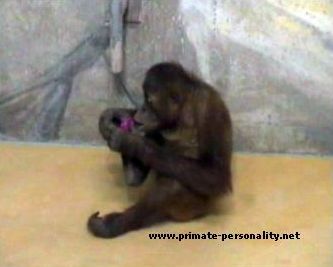
(© Foto: Jana Uher, Primate Personality Net,
MPI-EVAN & Humboldt University Berlin)
Some other tests studied how individuals respond to a pile of food or a banana in full view and almost in reach (Food out of reach test, Pile of food test; Uher et al., 2008, p. 103). Some individuals got quickly excited and, for example, vocalised or scratched a lot, whereas other individuals waited calmly and hardly showed any signs of arousal. Left picture: The actual test candidate Viringika is sleeping underneath the table, while her two-year-old daughter Kibara is sitting on her and cannot stop looking at the banana-just like Fraukje at the sight of the pile of fruit (right picture).
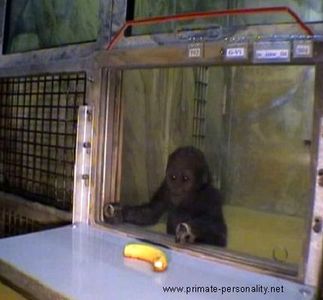

(© Fotos: Jana Uher, Primate Personality Net, MPI-EVAN
&
Humboldt University Berlin)
To investigate explorative behaviour, the apes were also given coloured pieces of food, such as apple slices, that were shaped in different ways (Novel food test; Uher et al., 2008, p. 103). The responses were very different. Some apes investigated the novel food intensely, played with it, and tasted and ate it. Others, in turn, completely ignored the strange looking items or immediately threw them back to the experimenter.
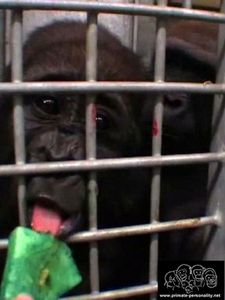
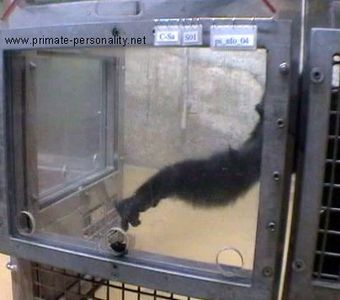
(© Fotos: Jana Uher, Primate Personality Net, MPI-EVAN
&
Humboldt University Berlin)
The apes' vigilance was investigated in the Hidden food test (Uher et al., 2008, p. 102) in which small pieces of food were hidden in the cage of the apes who did not know about this, such as small raisins (left photo) or a small dot of honey smeared at the coloured wall (right photo). Some individuals quickly spotted the sweet surprises, whereas it took others a long time to notice them - if they found the items at all.
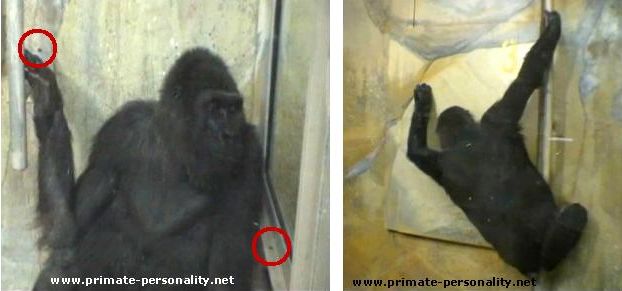
(© Fotos: Jana Uher, Primate Personality Net, MPI-EVAN & Humboldt
University Berlin)
How persistently great apes can deal with a task even in absence of a reward, was studied in the Button-box Test (Uher et al., 2008, p. 101). After two trials in which only four buttons were presented and pressing a button was always rewarded, the apes got access to 20 buttons, but were not rewarded any more for pressing buttons. Some individuals continued pressing the buttons (left), whereas others made themselves comfortable in a nest and pressed the buttons just here and then (right).
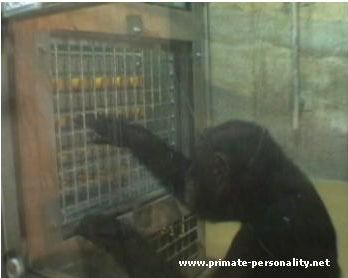

(© Fotos: Jana Uher, Primate Personality Net,
MPI-EVAN &
Humboldt University Berlin)
| These results demonstrate that the great apes show stable individual differences across a broad range of behaviours. The individual constellations of specific behavioural tendencies were also stable over time; they can be illustrated in "personality" profiles. For example, the combination of stable individual patterns in different behaviours of the chimpanzee female Sandra was remarkably similar in both periods of investigation (compare the continuous and broken profile lines in the figure)-this stable individual behavioural profile visually represents the scientific measurement of Sandra's "personality" across the entire time period of the study. |
This research was awarded several prizes for outstanding research.
Scientific publications:
Uher, J., Asendorpf, J. B., & Call, J. (2008). Personality in the behaviour of great apes: Temporal stability, cross-situational consistency and coherence in response. Animal Behaviour, 75, 99-112. https://doi.org/10.1016/j.anbehav.2007.04.018 [Download] [Highlights]
Uher, J. (2011b). Personality in nonhuman primates: What can we learn from human personality psychology? In A. Weiss, J. King, & L. Murray (Eds.). Personality and temperament in nonhuman primates (pp. 41-76). New York, NY: Springer. https://doi.org/10.1007/978-1-4614-0176-6_3 [Download] [Highlights]
Uher, J. (2008a). Comparative personality research: Methodological approaches [Target article]. European Journal of Personality, 22, 427-455. https://doi.org/10.1002/per.680 [paper request] [Highlights]
Uher, J. (2008b). Three methodological core issues of comparative personality research. European Journal of Personality, 22, 475-496. https://doi.org/10.1002/per.688 [paper request] [Highlights]
Uher, J. & Asendorpf, J. B. (2008). Personality assessment in the Great Apes: Comparing ecologically valid behavior measures, behavior ratings, and adjective ratings. Journal of Research in Personality, 42, 821-838. https://doi.org/10.1016/j.jrp.2007.10.004 [Download] [Highlights]
Last update: 14.09.2013
Keywords: Pan paniscus, Pan troglodytes, Gorilla gorilla, Pongo pygmaeus, individual differences, personality, judgment, rating, assessments, personality questionnaire, behavioural profiles, personality rating, chimpanzee, bonobo, gorilla, orangutan, great apes, primates.
